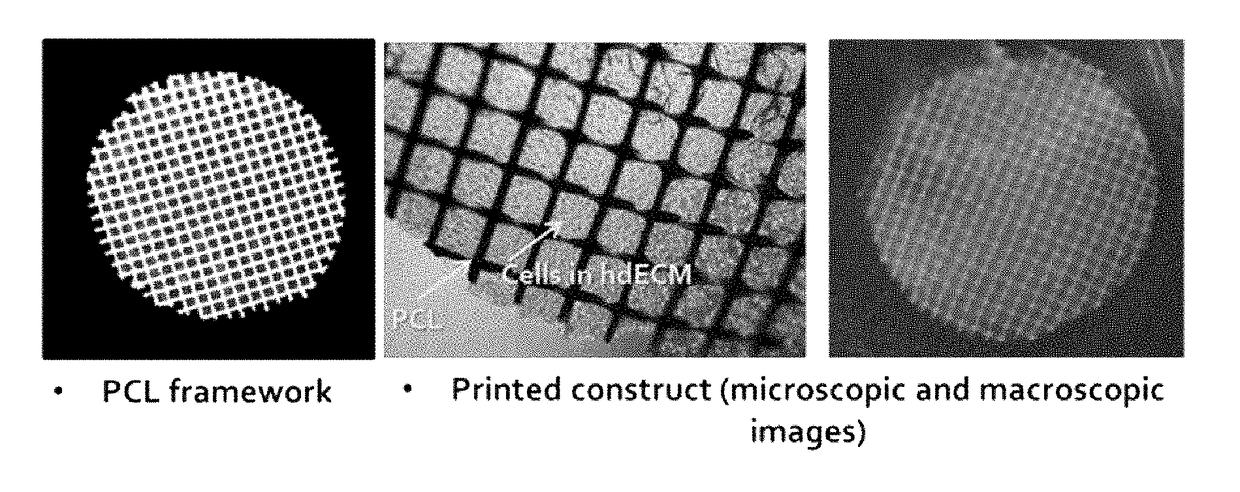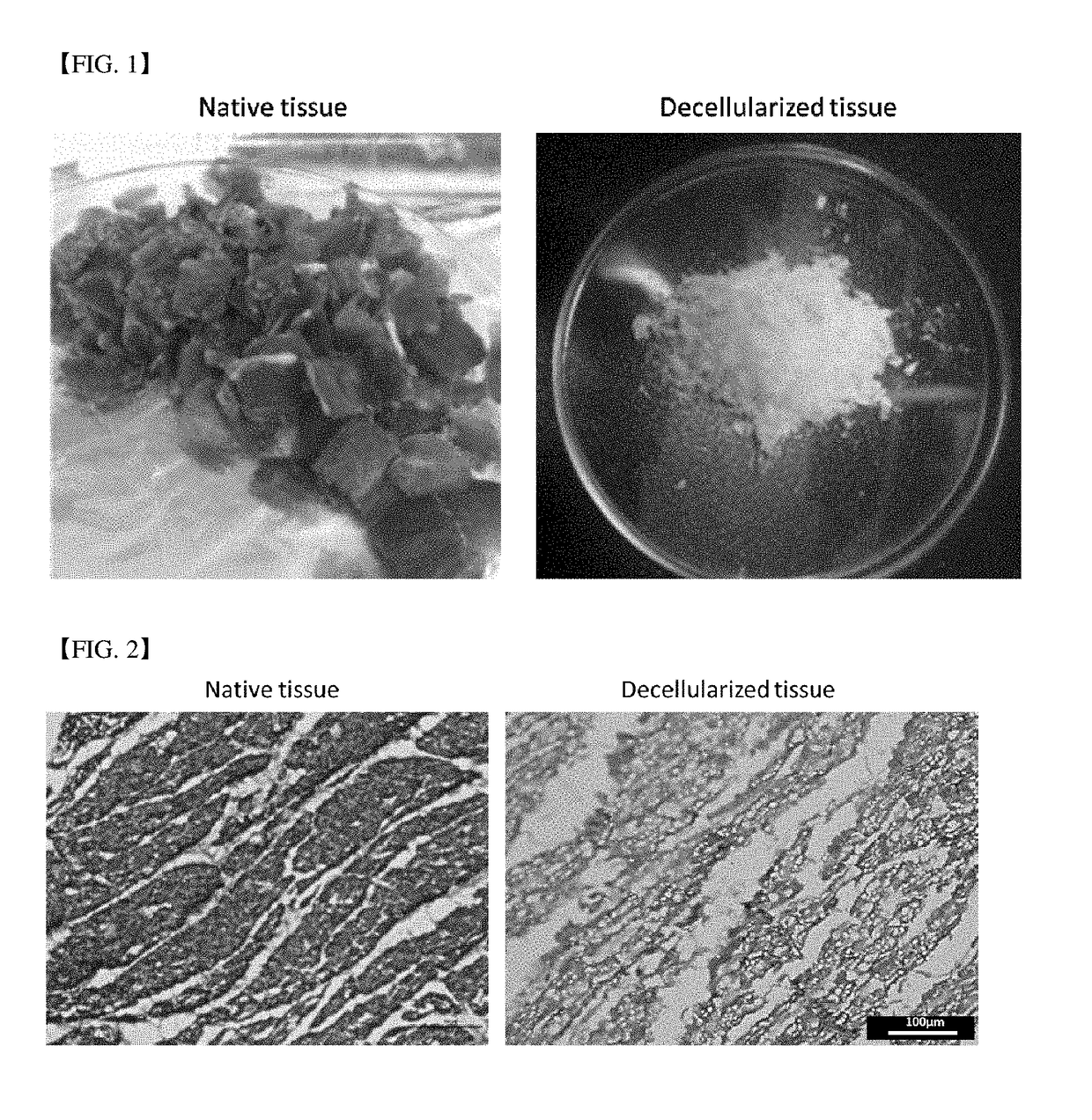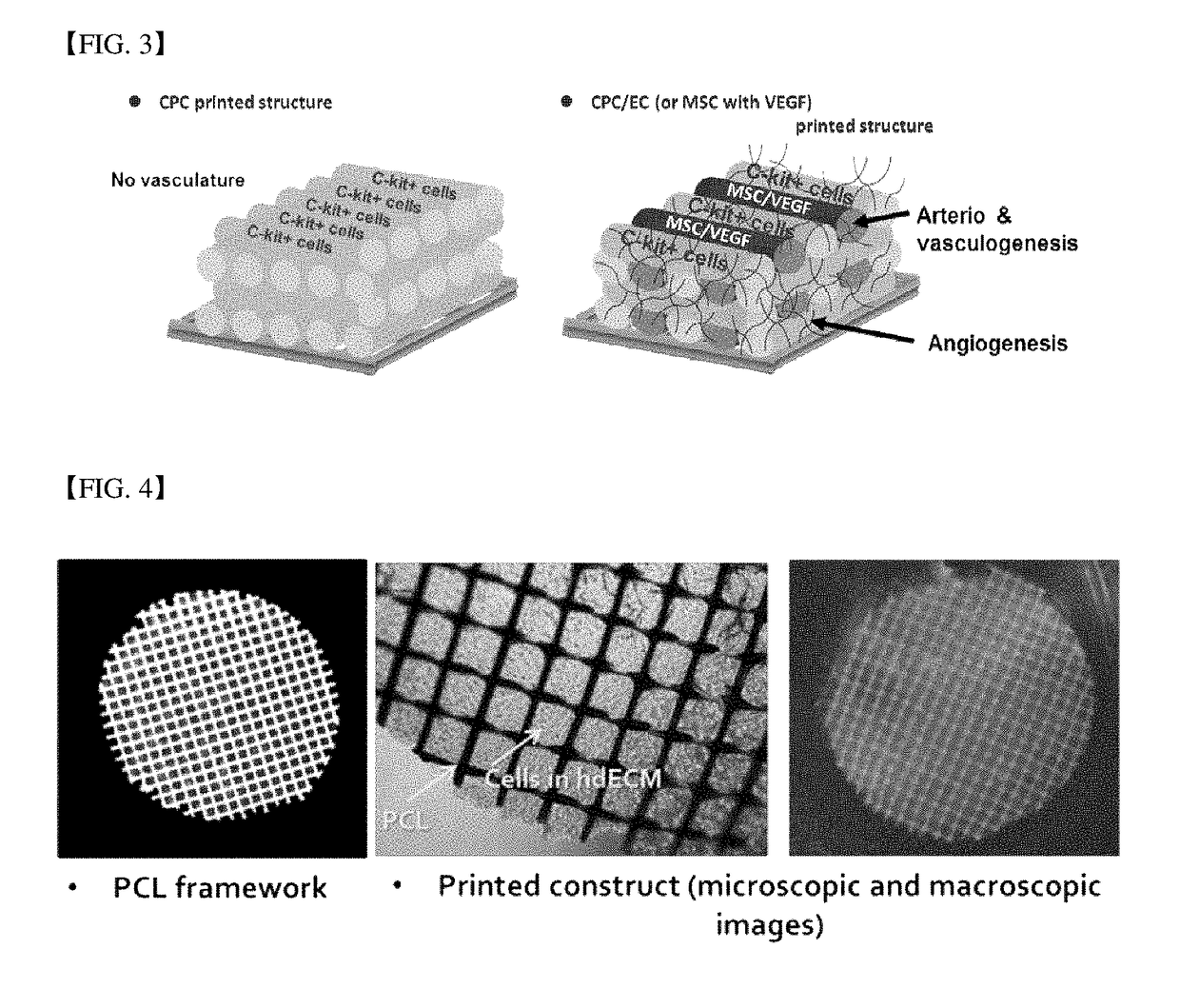Three-dimensional structure for cardiac muscular tissue regeneration and manufacturing method therefor
a cardiac muscle tissue and three-dimensional technology, applied in the field of three-dimensional construct preparation, can solve the problems of limited material choice, minimal cell-material interaction, inferior tissue formation, etc., and achieve the effect of effective implementation of the micro-environment of cardiac muscle tissue and significant improvement of cell transfer efficiency into the myocardium
- Summary
- Abstract
- Description
- Claims
- Application Information
AI Technical Summary
Benefits of technology
Problems solved by technology
Method used
Image
Examples
preparation example 1
rst Bioprinting Composition
[0091]1-1: Preparation of Decellularized Extracellular Matrix
[0092]Decellularized extracellular matrix was prepared according to a method disclosed in Falguni Pati, et al., Nat Commun. 5, 3935 (2014) using porcine cardiac tissues (hereinafter, ‘hdECM’). The prepared hdECM was finally lyophilized and kept frozen before used. The optical microscope photograph and tissue staining photograph were shown in FIG. 2.
[0093]1-2: Preparation of Pre-Gel Form of a Tissue Engineering Construct Forming Solution
[0094]Liquid nitrogen was poured to the obtained lyophilized hdECM and it was crushed with mortar and a pestle. After the obtained hdECM powder (330 mg) was added to 0.5M acetic acid aqueous solution (10 ml), and pepsin (33 mg) (P7125, Sigma-Aldrich) was added, it was stirred for 48 hrs at a room temperature. Maintaining the temperature of the obtained solution below 10° C., riboflavin (2 mg) was added and 10 NaOH solution which was cooled below 10° C. was added, t...
preparation example 2
cond Bioprinting Composition
[0097]2-1: Preparation of Decellularized Extracellular Matrix
[0098]Decellularized extracellular matrix was prepared according to a method disclosed in Falguni Pati, et al., Nat Commun. 5, 3935 (2014) using porcine cardiac tissues (hereinafter, ‘hdECM’). The prepared hdECM was finally lyophilized and kept frozen before used. The optical microscope photograph and tissue staining photograph were shown in FIG. 2.
[0099]2-2: Preparation of Pre-Gel Form of a Tissue Engineering Construct Forming Solution
[0100]Liquid nitrogen was poured to the obtained lyophilized hdECM and it was crushed with mortar and a pestle. After the obtained hdECM powder (330 mg) was added to 0.5M acetic acid aqueous solution (10 ml), and pepsin (33 mg) (P7125, Sigma-Aldrich) was added, it was stirred for 48 hrs at a room temperature. Maintaining the temperature of the obtained solution below 10° C., riboflavin (2 mg) was added and 10 NaOH solution which was cooled below 10° C. was added, ...
example 1
on of a Three-Dimensional Construct for Tissue Engineering
[0105]A three-dimensional construct was fabricated using the first bioprinting composition and the second bioprinting composition obtained from the preparation examples 1 and 2.
[0106]Specifically, polycaprolactone (PCL) framework was loaded on the syringe (the first syringe) of multi-head tissue and organ printing system (Jin-Hyung Shim et al., J. Micromech. Microeng. 22 085014 (2012)), and it was heated at approximately 80° C. to melt a polymer. The pre-gel form of the first bioprinting composition obtained from the preparation example 1 and the second bioprinting composition obtained from the preparation example 2 were loaded on another syringe (the second and third syringes, respectively), and the temperature was maintained below approximately 10° C. A thin PCL framework having below approximately 100 um line width, approximately 300 um of gap and 120 um of thickness by putting approximately 600 kPa of pneumatic pressure t...
PUM
 Login to View More
Login to View More Abstract
Description
Claims
Application Information
 Login to View More
Login to View More - R&D
- Intellectual Property
- Life Sciences
- Materials
- Tech Scout
- Unparalleled Data Quality
- Higher Quality Content
- 60% Fewer Hallucinations
Browse by: Latest US Patents, China's latest patents, Technical Efficacy Thesaurus, Application Domain, Technology Topic, Popular Technical Reports.
© 2025 PatSnap. All rights reserved.Legal|Privacy policy|Modern Slavery Act Transparency Statement|Sitemap|About US| Contact US: help@patsnap.com



